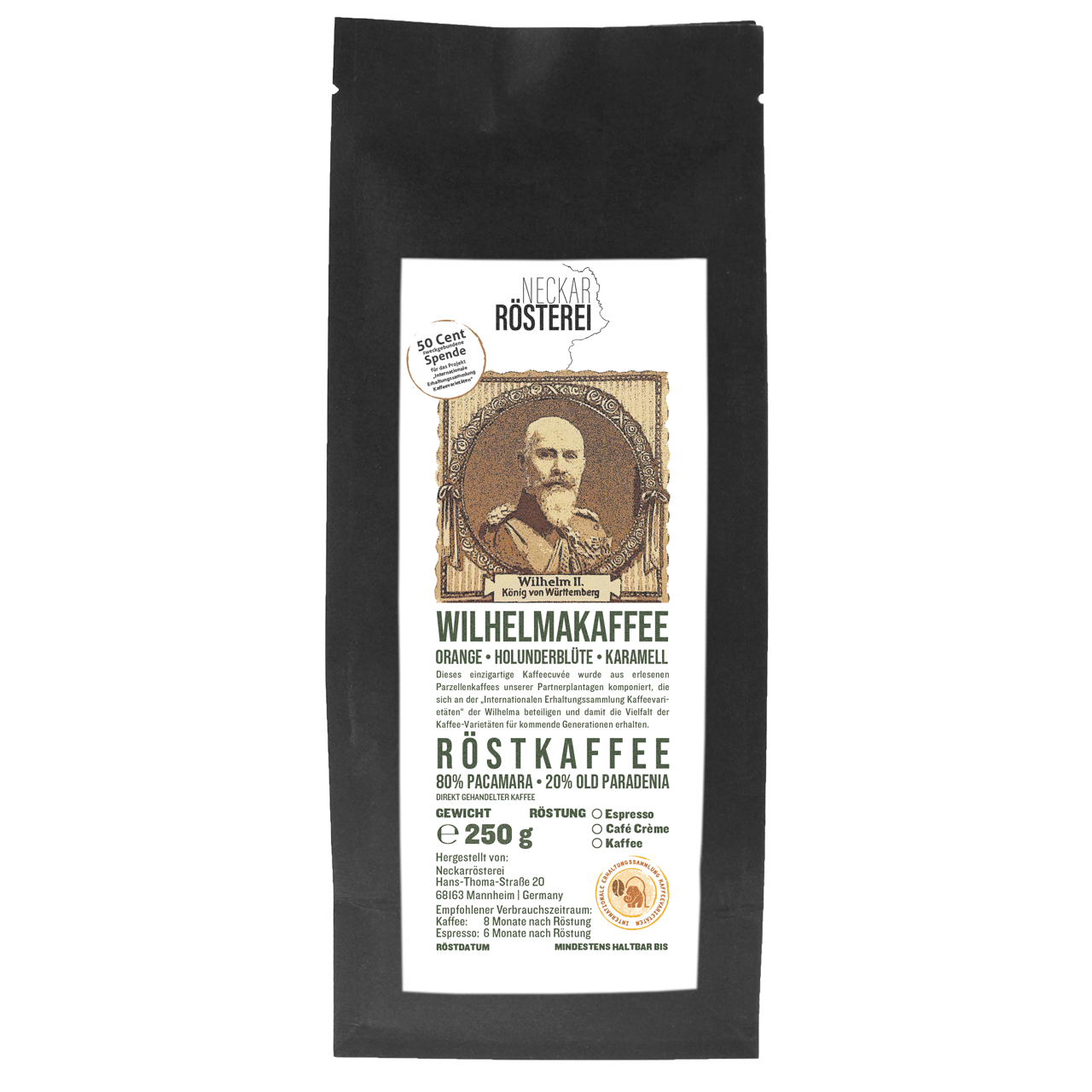The coffee blend ‘King Wilhelm II of Württemberg’ is also the official ‘Wilhelma coffee’, and a portion of the sales proceeds goes towards establishing and maintaining the ‘International Conservation Collection of Coffee Varieties’ at Wilhelma in Stuttgart. This means that every purchase directly and immediately supports the preservation of the biodiversity of coffee varieties worldwide.
Coffee is one of the most popular beverages worldwide. The abundance of specialities and creations continues to grow, but studies show that the diversity of coffee plants themselves is at risk. As a zoological and botanical garden, Wilhelma in Stuttgart is therefore establishing an ‘International Conservation Collection for Coffee Varieties’, which it presented for the first time at INTERGASTRA, the trade fair for gastronomy and the hotel industry, in February 2020. 60 percent of wild coffee species are considered threatened with extinction. ‘Species conservation is a central concern for us, both for plants and animals,’ said Wilhelma Director Dr Thomas Kölpin. ‘In the long term, it can only be successful if there is a global rethink, but we can contribute locally with this conservation breeding programme to ensure that the species are not lost entirely.’ At INTERGASTRA, plantation owners among the exhibitors handed over further seeds to Kölpin and Peter Hauk, Minister for Rural Affairs and Consumer Protection. ‘Biodiversity is an irreplaceable asset,’ emphasised Hauk. "That is why the state of Baden-Württemberg is officially registering the project as a conservation collection. With more than 60 rare varieties and species, it is already one of the most important collections internationally. This project is very much in line with our intention to strengthen regionality and thus protect the climate."
The background to this is that of the more than 100 known species of coffee plants, only three are used commercially on a large scale: Coffea Canephora (known as Robusta) is considered a mass product, while Coffea Arabica is regarded as a premium variety. The third variety used, Coffea Liberica, bears relatively little fruit on tall trees, which is why its use is less attractive economically. However, breeders have produced over 500 varieties from these three species over the past 500 years. ‘These varieties not only differ in appearance and taste,’ explained Dr Björn Schäfer, head of the botany department at Wilhelma, ‘they have developed individual characteristics that allow them to cope with different soils, climatic conditions and harmful fungi, viruses or bacteria.’ Extreme weather conditions are on the rise, and individual pest species can completely destroy a monoculture. For example, the most important banana variety, ‘Cavendish,’ is dying out worldwide due to a harmful fungus because only genetic clones that are defenceless against the pathogen are cultivated everywhere. ‘That is why it is crucial to preserve coffee plants with versatile defences for future generations,’ says Schäfer. Wilhelma therefore obtains the varieties outside their natural growing areas in case natural disasters such as floods, droughts, fires or epidemics of plant diseases destroy them in their natural habitats.
‘This can only succeed with an intercontinental network, but the great interest shown by coffee farmers is helping us,’ says Dr Steffen Schwarz from the Coffee Consulate. The independent training and research centre in Mannheim has established contacts with high-quality plantations in many countries for the project. Wilhelma now grows coffee from Brazil, China, El Salvador, India, Malaysia, Mexico and Thailand. Wilhelma is now represented at the trade fair to engage in conversation with guests at the Coffee Summit Stuttgart. ‘Our goal is to attract plantation owners from other important coffee regions that are not yet represented in the project,’ says Schäfer. ‘We would be very pleased to welcome new additions from Ethiopia, Guatemala, Yemen, Kenya, Colombia, Oman, Peru and Vietnam, for example.’
As ambassadors for the new collection, the partners have developed their own ‘Wilhelmakaffee’ coffee. It was available for tasting at the trade fair. The coffee cherries used to make it come exclusively from the sustainable plantations of the cooperation partners. The Neckar roasting plant in Mannheim creates a cuvée from a blend of Pacamara and Old Paradenia beans. During an initial tasting, coffee connoisseurs detected nuances of orange, elderflower and caramel. A portion of the proceeds will go towards expanding the international conservation collection.
Some of the coffee bushes can be seen year-round in the Moorish House in the tropical crops section of the Zoological and Botanical Garden in Stuttgart. In future, there will also be an annual exhibition of the growing coffee plant collection in February, when it bears fruit.
This unique coffee cuvée was composed from selected parcel coffees from our partner plantations, which participate in Wilhelma's ‘International Conservation Collection of Coffee Varieties’ and thus preserve the diversity of coffee varieties for future generations.
Aromas:
Orange, elderflower, caramel
Blend:
80% Yellow Pacamara, pulped natural (Fazendas Dutra, Brazil)
20% Old Paradenia, fully washed (Badra Estates, India)

